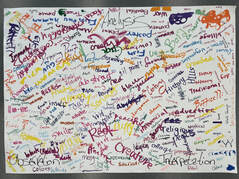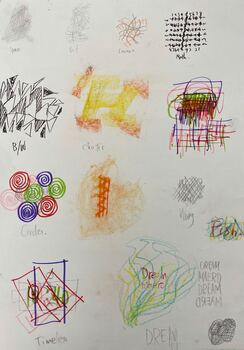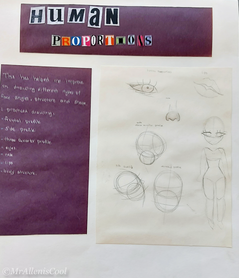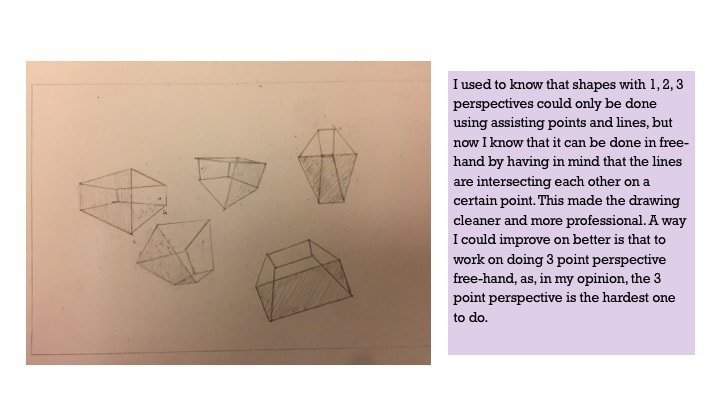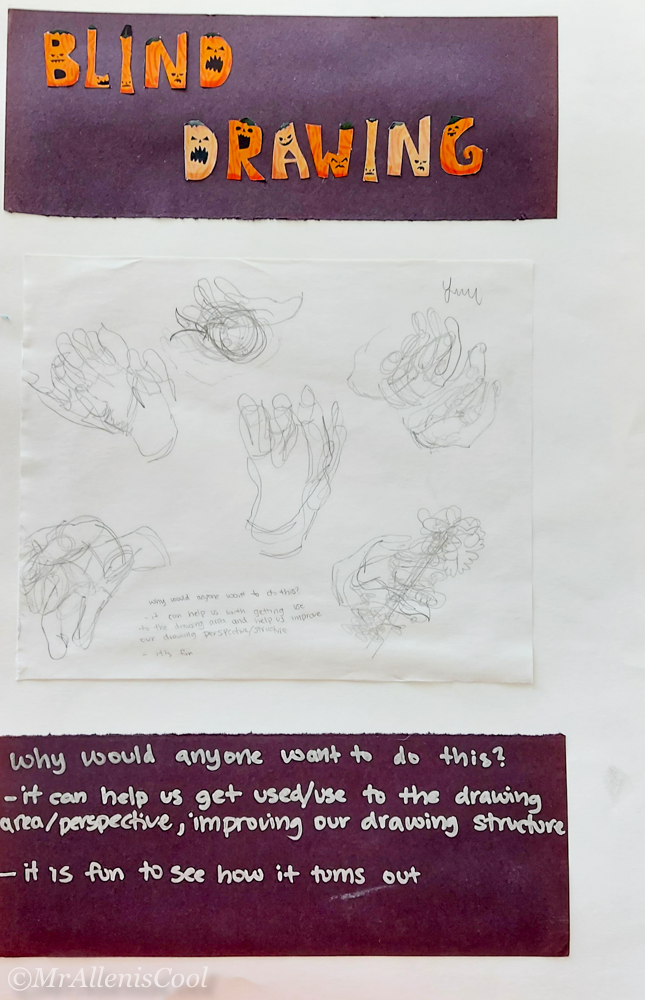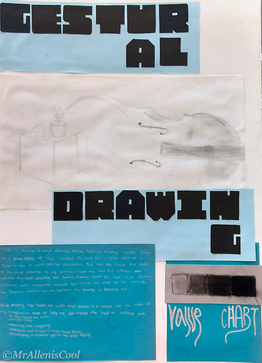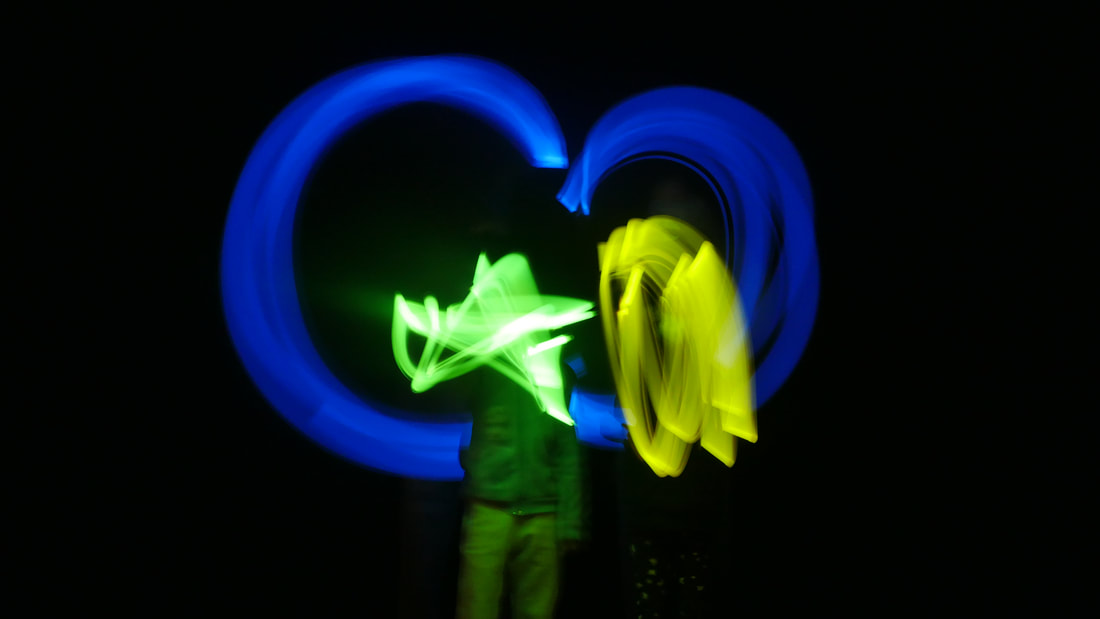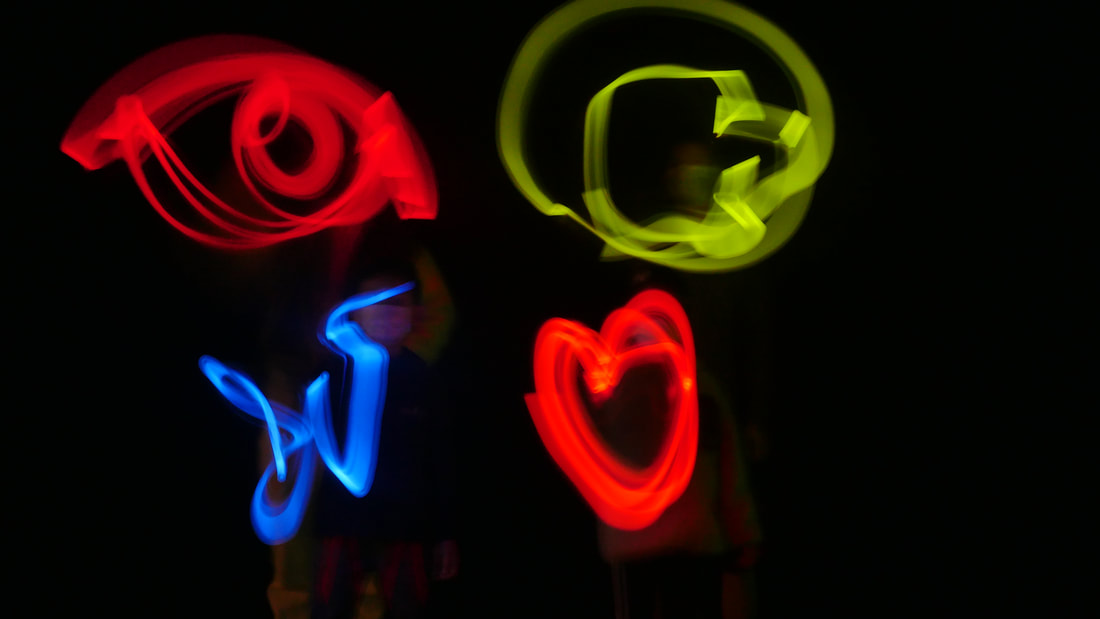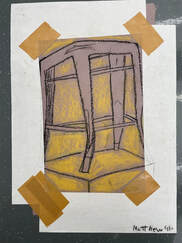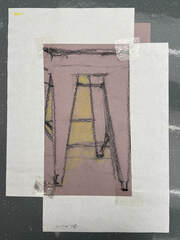Drawing Emotion and Reason
This unit is the first unit in Art I. It explores using technical and intuitive methods of drawing, drawing materials, and is intended to be the foundation which underpins the painting, printmaking, and art history units. Give it a try for yourself and your students!
| unit_1_emotion_and_reason_drawing.pdf | |
| File Size: | 120 kb |
| File Type: | |
Drawing Emotion and Reason Lessons in Sequence
Five by Two
Content Objective: I can begin to form ideas about works of art.
Language Objective: I can attach a concept to a work of art and consider how that concept fits into a framework of thought.
Culture Objective: I can look at art from different cultures and make an intuitive assessment.
Thinking Skill Questions
Symbolic: What do I see that I can identify with?
Flow: What does the imagery remind me of?
Epistemological: What is the artist trying to communicate?
Look at and image and write down the first five things that come to mind. Look away, take a breath, then look at the image again. Write down five more things that come to mind. Chose one or two words from your lists, and plot them on the Observation - Interpretation - Analysis continuum.
For example, any word that is a direct observation, like 'person' would be plotted closer to Observation. Any word in which you add meaning, like 'isolation' would go closer to the Interpretation end. Plot the word vertically near the top, closer to Analysis depending on how much time it took you to think of the word.
Teaching protocol adapted from Project Zero's Ten Times Two
Content Objective: I can begin to form ideas about works of art.
Language Objective: I can attach a concept to a work of art and consider how that concept fits into a framework of thought.
Culture Objective: I can look at art from different cultures and make an intuitive assessment.
Thinking Skill Questions
Symbolic: What do I see that I can identify with?
Flow: What does the imagery remind me of?
Epistemological: What is the artist trying to communicate?
Look at and image and write down the first five things that come to mind. Look away, take a breath, then look at the image again. Write down five more things that come to mind. Chose one or two words from your lists, and plot them on the Observation - Interpretation - Analysis continuum.
For example, any word that is a direct observation, like 'person' would be plotted closer to Observation. Any word in which you add meaning, like 'isolation' would go closer to the Interpretation end. Plot the word vertically near the top, closer to Analysis depending on how much time it took you to think of the word.
Teaching protocol adapted from Project Zero's Ten Times Two
Media Testing
Content Objective: I can learn the nature of media through experimentation.
Language Objective: I can attach adjectives to the experience I had.
Culture Objective: I can better understand how I connect emotion and image.
Thinking Skills
Flow: What is my intuitive response to the media? How can I put it into words?
Activating working memory: What do I discover by using this media? How can I be deliberate with it?
In your sketchbook play around with different kinds of drawing material such as various grades of pencil, charcoal, pastel, ink, marker, etcetera. You can draw or sketch anything you like and each drawing should be small. Under each write an adjective that describes your experience and feeling towards the material. Feel free to be creative and lighthearted with this part. Adjectives may be written in English, Chinese, or Korean.
After you have completed at least twelve, choose at least five of the materials and write your name in a variety of different ways with those materials.
Include a photo of at least one page of your media testing, your name art, and answer the following questions:
Upon reflection, how accurate are the adjectives I wrote under each term?
Select three mediums you like and/or feel the most comfortable with. State them in this screen. Write two more adjectives for each.
Content Objective: I can learn the nature of media through experimentation.
Language Objective: I can attach adjectives to the experience I had.
Culture Objective: I can better understand how I connect emotion and image.
Thinking Skills
Flow: What is my intuitive response to the media? How can I put it into words?
Activating working memory: What do I discover by using this media? How can I be deliberate with it?
In your sketchbook play around with different kinds of drawing material such as various grades of pencil, charcoal, pastel, ink, marker, etcetera. You can draw or sketch anything you like and each drawing should be small. Under each write an adjective that describes your experience and feeling towards the material. Feel free to be creative and lighthearted with this part. Adjectives may be written in English, Chinese, or Korean.
After you have completed at least twelve, choose at least five of the materials and write your name in a variety of different ways with those materials.
Include a photo of at least one page of your media testing, your name art, and answer the following questions:
Upon reflection, how accurate are the adjectives I wrote under each term?
Select three mediums you like and/or feel the most comfortable with. State them in this screen. Write two more adjectives for each.
Perspective Drawing
Content Objective: I can practice a traditional form of drawing.
Language Objective: I can connect the practice to the word.
Culture Objective: I can engage with traditional drawing approaches
Thinking Skills
Activating working memory: Do I have enough space to do this? What tools do I need? What do I need to pay close attention to?
Technical: Questions about how a task is executed. What are the respective points I need to have my lines vanish to? Which points vanish in which direction?
Following class instruction and the resources from the Chris Solarski book, experiment and play with one-, two-, and three-point perspective. Do this on larger paper, not your sketch book then place the drawings into your portfolio.
Content Objective: I can practice a traditional form of drawing.
Language Objective: I can connect the practice to the word.
Culture Objective: I can engage with traditional drawing approaches
Thinking Skills
Activating working memory: Do I have enough space to do this? What tools do I need? What do I need to pay close attention to?
Technical: Questions about how a task is executed. What are the respective points I need to have my lines vanish to? Which points vanish in which direction?
Following class instruction and the resources from the Chris Solarski book, experiment and play with one-, two-, and three-point perspective. Do this on larger paper, not your sketch book then place the drawings into your portfolio.
Human Proportions
Content Objective: I can apply different ways to accurately draw the human body.
Language Objective: I can discuss my drawing practice clearly.
Culture Objective: I can see different ways the human body has been represented over time.
Thinking Skills:
Symbolic: How have artists before me drawn the human figure accurately?
Sacred: How can different ways of doing something both be correct?
Using the instructions in class and the Chris Solarski book, practice and experiment with drawing the human figure. A fully finished drawing isn’t required but at least three sketches and drawings that show your explorations. You may complete these in your sketchbook or on larger paper.
Collect your perspective drawings and human drawings together, put at least three photographs of your work – more is ok then answer at least two of the following questions directly on your drawings or in the growth portfolio screen in either English or Chinese. If you write Korean expect to translate for me. Responses to questions should be twenty words, more or less. Larger drawings should go in your portfolio. Images of your drawings and responses should be put in the growth portfolio.
Questions:
How have my skills in drawing improved?
When do I think I will use any of these techniques in the future?
Do I look at things differently now? If so, how?
Have I ever used some of these techniques in the past? If so when?
Is there a specific type of media that fits these techniques best? If so, how?
In the last two lessons I refer to the Chris Solarski Book - Drawing Basics and Video Game Art - Great resource!
Content Objective: I can apply different ways to accurately draw the human body.
Language Objective: I can discuss my drawing practice clearly.
Culture Objective: I can see different ways the human body has been represented over time.
Thinking Skills:
Symbolic: How have artists before me drawn the human figure accurately?
Sacred: How can different ways of doing something both be correct?
Using the instructions in class and the Chris Solarski book, practice and experiment with drawing the human figure. A fully finished drawing isn’t required but at least three sketches and drawings that show your explorations. You may complete these in your sketchbook or on larger paper.
Collect your perspective drawings and human drawings together, put at least three photographs of your work – more is ok then answer at least two of the following questions directly on your drawings or in the growth portfolio screen in either English or Chinese. If you write Korean expect to translate for me. Responses to questions should be twenty words, more or less. Larger drawings should go in your portfolio. Images of your drawings and responses should be put in the growth portfolio.
Questions:
How have my skills in drawing improved?
When do I think I will use any of these techniques in the future?
Do I look at things differently now? If so, how?
Have I ever used some of these techniques in the past? If so when?
Is there a specific type of media that fits these techniques best? If so, how?
In the last two lessons I refer to the Chris Solarski Book - Drawing Basics and Video Game Art - Great resource!
|
Blind Drawing
Content Objective: I’ve experimented with using my eye and hand in tandem. Language Objective: I can elicit the benefits of a technique. Culture Objective: I am gaining better control over seeing and moving. Thinking Skills: Symbolic: How do I translate the images I see in my mind to my hand? Why is developing hand-eye coordination important in the visual arts? This is a style of drawing where we do not look at our image until we are complete. The goals are to force you eye to look the object you are drawing, to train your eye and hand to work together, and to have a good laugh. There are several activities including:
Why would anyone ever want to do this? |
|
Gestural Drawing
Content Objective: I can use an intuitive method for drawing accurately. Language Objective: I can compare drawing techniques. Culture Objective: I am beginning to understand the scope of drawing techniques. Thinking Skills: Salient: How do these techniques use seeing and rendering from the one we previously studied? Technical: What do I need to focus my attention on? Gestural drawing is where we use our arms and eyes in a non-measured way. Trusting on our intuition and physicality to accurately render what we are seeing. Begin by drawing with your arm and shoulder. Avoid small delicate marks at first and aim to capture the entire subject as a whole. Sighting is using you pencil, or other object to ensure the angles of your subject matter. Hold you pencil at arm's length and tilt it to the same angle as a part of your subject. Keep the pencil at the same angle and move it to your paper and make yourself a line at the corresponding angle. Move around the subject matter until you have a reliable structure to build your drawing from. I have found that your paper (or other substrate) should be directly in front of your subject matter, and you should aim to keep the eye at a 90-degree angle to your paper. Follow the in-class instructions and complete your work on large paper. At the end of the class answer the following questions directly on your drawings. Place your drawings in your portfolio. Questions: How is this like blind drawing? Are there aspects of blind drawing that helped you with this exercise? If so, what? Did you find yourself referencing perspective drawing during this exercise? |
|
|
|
Light Drawing
Content Objective: I can use my whole body as a gestural drawing tool. Language Objective: I can explain something to classmates younger than I in simple language. Culture Objective: I can help develop a sense of school of community by working with younger students. Thinking Skills: Communication: How do I best relay instructions to my peers? This is a buddy class. We should find a primary school class and assign one HS student to two or three ES students. The goal is to build confidence in both groups of students and to create a sense of school community. So, this is a whole lot of fun and gets your entire body into the drawing process. You’ll need a completely dark room, light sticks, a camera on a tripod, and if you can secure it music and a dance teacher. Start with basic motions, circles, triangles, etcetera. Then dance around a bit. Finally, try to make scenes by drawing with light. The camera needs to be set to bulb or a very long exposure time, like ten seconds. Turn the lights off completely, open the shutter, draw with your glow stick, close the shutter. This needs a lot little bit of playing around to get the hang of it but will become intuitive before too long. |
Positive and Negative Space
Content Objective: I can understand special relationships in a two-dimensional work of art.
Language Objective: I can use Positive and negative space when analyzing. Work of art.
Culture Objective: I am aware of an important way we look at and describe visual art.
Thinking Skills:
Technical: what methods can I use to recreate the negative space? How do I ensure I place shapes in an order which reveals something else?
Using the class instructions as well as the Edwards’ book, create an image by first outlining the subject matter so that it touches the edge of the picture plane in at least three places. Trace the negative space and transfer those shapes to coloured paper. Cut out the coloured paper and recreate the positive space by assembling the negative space. You may do this in your sketchbook or larger paper.
*The theory for this lesson is take from Betty Edward's book Drawing on the Right Side of the Brain
Language Objective: I can use Positive and negative space when analyzing. Work of art.
Culture Objective: I am aware of an important way we look at and describe visual art.
Thinking Skills:
Technical: what methods can I use to recreate the negative space? How do I ensure I place shapes in an order which reveals something else?
Using the class instructions as well as the Edwards’ book, create an image by first outlining the subject matter so that it touches the edge of the picture plane in at least three places. Trace the negative space and transfer those shapes to coloured paper. Cut out the coloured paper and recreate the positive space by assembling the negative space. You may do this in your sketchbook or larger paper.
*The theory for this lesson is take from Betty Edward's book Drawing on the Right Side of the Brain
The next two lessons I late combined into a translanguinng lesson you can find the video on my You Tube Channel and on the videos page of this website.
Venn Diagram
Content Objective: I can understand the relationships between the different language techniques.
Language Objective: I can select categories for drawing techniques. Culture Objective: I can learn through conversation with classmates Thinking Skills: Activating past memory: How have I used the techniques in this unit? Communication: How do I best explain to my classmates my own thoughts? First answer the following prompts on your own. Then get together with your randomized friend, or two and discuss your answers by plotting them on a Venn Diagram. You may do this physically or digitally. Turn in through Dx. Prompts: In what situations would you use Measured and Gestural drawing? Have at least four. Which specific techniques do you find easiest and most difficult? How are perspective and positive negative drawing similar and different? How are perspective drawing and sighting similar and different? In your opinion, which media fits with which techniques? How is the human proportions techniques similar and different to other techniques we studied in this unit? What, if any techniques could fall into both categories of measured and gestural drawing? Get together with a partner and compare your answers to the prompt above. Using your discussion create a Venn diagram that compares measured drawing (perspective, human proportions) and gestural drawing (blind drawing, sighting, and positive/negative space.). Include the following terms in your Venn diagram as well.
|
Terminology Quiz
Content Objective: I can review the terminology we have used in this unit.
Language Objective: My confidence with terminology is increasing. Culture Objective: I can see the connection between language and ideas. Thinking Skills: Activating past memory: When I have a seen these terms before and in what context? Sacred: How important is it that some words have similar terminology and definitions? Look through the list of terminology. Categorize the words, which do you know, which do you think you know, which do you not know. If English is your mother tongue, translate some of these into your Language B. If English i snot your mother tongue, then translates some of the words you need. Write definition for five of the terms. You may use English, Chinese, or Korean. make sure you find the visual arts definition for the visual arts definition for the words. Make these definition a new screen in your Growth Portfolio. Take the quiz about drawing terminology. It will not be counted as a an assessment towards your final grade but rather as an assessment to see how much you know and reinforce and refine some concepts. Place a screen shot of your score in your Growth Portfolio.
| ||||||
